Uttarakhand is often referred to as the “Dev bhumi,” which is surrounded by mountains and Rich, vibrant forests. Uttarakhand is not only famous for its beauty but also famous for its rich basins of biodiversity and Medicinal Plants in Uttarakhand. In Uttarakhand, the custom of using medicinal plants in Uttarakhand for wellness is deeply rooted in tradition and sentiment, becoming a vital part of people’s daily lives and being closely related to the state’s culture and spirituality.
The traditional methods of healing practiced in Uttarakhand are similar to those followed in Ayurveda, Unani and Tibetan medicine.
If you’re an aspiring herbal entrepreneur or someone exploring sustainable investment opportunities, this guide to the most profitable medicinal plants to grow in India, particularly in Uttarakhand, will offer valuable insights.
In this blog, we’ll explore the top 10 medicinal plants in Uttarakhand, their benefits, and why investing in medicinal plant farming can be a rewarding venture.
How Medicinal Plants Are Shaping Health and Economy in Uttarakhand
- Ancient Wellness Tradition: Medicinal plants have been used in Uttarakhand for centuries as part of traditional healing systems like Ayurveda.
- Rising Global Demand: There’s a growing shift toward natural and preventive healthcare, increasing the demand for herbal products worldwide.
- Government & NGO Support: Various initiatives are promoting the cultivation and conservation of medicinal plants in Uttarakhand, aiming to protect biodiversity and support local livelihoods.
- Economic Opportunities: Medicinal plant farming offers profitable ventures for small farmers and rural entrepreneurs, supported by government policies and a booming herbal market.
- Sustainable Development: Cultivating medicinal plants supports eco-friendly practices while generating income, making it a win-win for people and the planet.
Top 10 Profitable Medicinal Plants in Uttarakhand
Here are ten medicinal plants from Uttarakhand that are highly sought after in the market:
1. Ashwagandha (Withania somnifera)
“Ashwagandha” often called Indian ginseng, is a powerful adaptogen that helps the body manage stress. With the wellness and fitness industry booming, its global demand has skyrocketed. This medicinal plants in Uttarakhand, it grows well in the hilly regions with low humidity. From capsules to herbal teas and powders, Ashwagandha is a key ingredient in natural supplements.
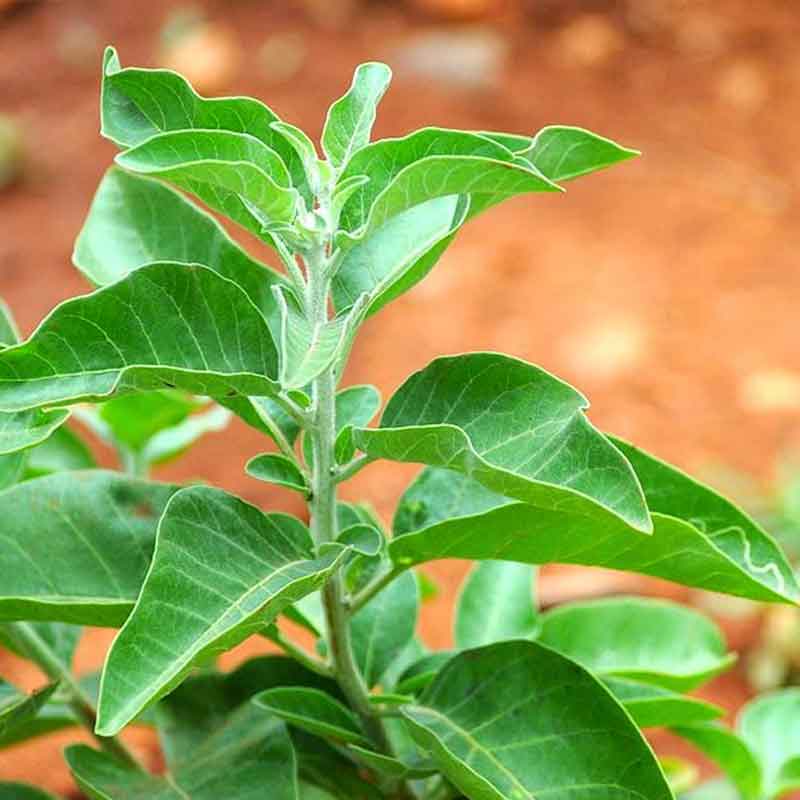
- Market Demand: Very high in the US, Europe, and India. Global demand is very high, especially in the U.S., Europe, and India. Ashwagandha powder sells at ₹200–₹400/kg wholesale; value-added products can fetch 3–5 times more. Used extensively in wellness, stress relief, and adaptogenic supplements.
- Investment Potential: Ideal for contract farming and organic cultivation.
- Medical uses: This medicinal plant in Uttarakhand is a powerful adaptogenic herb, and its roots and leaf extracts are used to reduce stress and anxiety, enhance energy and stamina, improve immunity and overall vitality, support brain function and memory, and reduce inflammation and regulate blood sugar.
- Best Farming Areas: Ashwagandha medicinal plants in Uttarakhand, Haridwar, Dehradun (lower hills), Udham Singh Nagar
2. Giloy (Tinospora cordifolia)
“Giloy” is often called “Garhwali” in the local area. This plant is one of the most revered Ayurvedic herbs from Uttarakhand. Giloy is a robust, low-maintenance, and high-demand medicinal plant that grows well in Uttarakhand. It is a climbing shrub with heart-shaped leaves that produces meaty, red fruits when ripe.

- Market Demand and Economic Value: Giloy witnessed a high demand in the post-COVID-19 days because it is an immune booster. If we talk about prices, the dried giloy stem costs between ₹120 per kg, based on the quality and processing required.
- Cultivation Potential: This medicinal plants in Uttarakhand occurs naturally in subtropical and tropical regions in forests and semi-arid areas. Grow in a well-drained loamy soil with average water needs. Harvesting can begin within 12–15 months of planting.
- Medical uses: It is known for its powerful immunomodulatory, antipyretic, anti-inflammatory, and detoxifying properties. This plant offers boosting immunity and resistance to infections and managing chronic fever and dengue
- Best Farming Areas: Mainly giloy grows in Dehradun, Nainital, Haridwar, Almora, and Rudraprayag.
3. Kutki (Picrorhiza kurroa)
“kutki” (Picrorhiza kurroa), a scarce and precious Himalayan herb indigenous to Uttarakhand, which is renowned for its strong liver-protecting. Scarce natural availability, combined with heavy demand, means high-profit potential for trained farmers in alpine regions.
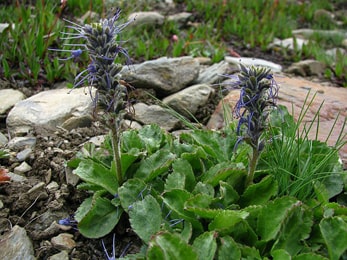
- Market Demand: Kutki is a highly traded high-altitude herb. This plant is in significant demand in both pharmaceutical and herbal sectors. Kutki is one of the main ingredients of liver tonics and immunity boosters! The price range of kutki is around ₹3,000 per kg, depending on purity and availability.
- Cultivation Potential: Grows naturally on a tree with averaging 40-60 feet; occurs at 2,500-4,000 meters in elevation and thrives in cool, wet alpine climates and well-drained humus-rich soil. Farmers might receive buy-back guarantees and premium pricing.
- Medical uses: Kutki is a very important herb in Ayurveda. It is widely known to have effects on the liver, the digestive system, and immunity. While at the same time increasing digestion and metabolism.
- Best farming Areas: Chamoli, Pithoragarh, Rudraprayag, and Uttarkashi districts.
4. Jatamansi (Nardostachys jatamansi)
“Jatamansi” (Nardostachys jatamansi) is one of the best and most valued Himalayan herbs with calming, memory-enhancing, and anti-stress properties. It has a huge demand in herbal, aromatic, and wellness sectors with its price, which continues to increase, making it the best cash crop for farmers in the high-altitude areas of Uttarakhand.
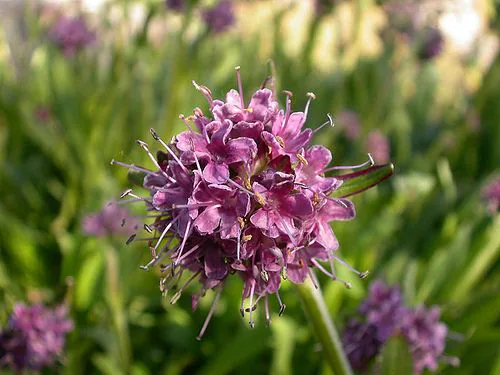
- Demand in the market: This plant is highly demanded in the herbaceutical, perfumery, and cosmetic industries and utilized in Ayurvedic products, natural perfumes, and aromatherapy oils. It is sold as dry rhizomes (₹2000 per kg for ordinary quality and ₹5,000 per kg for best quality).
- Cultivation Potential: Jatamansi Likes cool, moist, shady places where humus-rich and well-drained soil exist and can be grown under high altitude agro forestry or shade-net environment. It takes 3-4 years to mature for rhizome harvest.
- Medical uses: Jatamansi is one of the powerful Ayurvedic herbs of Uttarakhand, calming and brain rejuvenating herb. This plant Serves as a natural nervine tonic that eases stress, anxiety, and insomnia.
Best farming Areas: Chamoli, Uttarkashi, Pithoragarh, and Rudraprayag.
5. Chirata (Swertia chirayita)
“Chirata” (Swertia chirayita) is a bitter Ayurvedic plant traditionally used to treat fever, liver issues, and skin ailments. Chirata, native to the middle-altitude Himalayas, is in high demand both locally and internationally. Wild harvesting is currently threatened in its native environment, but cultivation using sustainable methods can provide a viable source of income for farmers in Uttarakhand, particularly in temperate locations.
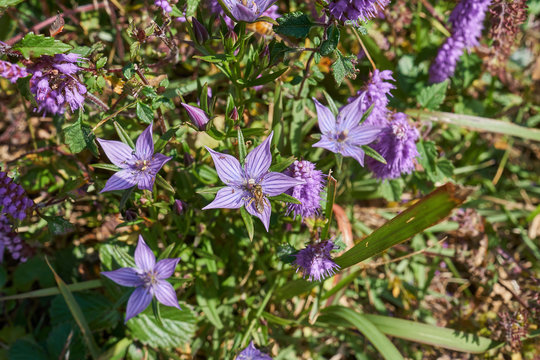
- Market demand: This plant is highly in demand in Ayurvedic and folk medicine in the form of powders, syrups, and tablets. Exported for use in homeopathy and herbal medicine in Europe and Asia. The dried chirata rate is ₹200–₹600/kg in India, which varies depending on the place.
- Cultivation Potential: Chirata grows in the Himalayas at an altitude of 1,200 to 2,500 meters and thrives in cool and moist climates with loamy soil, good drainage, and partial shade.
- Medical uses: Chirata is a famous bitter tonic herb in Ayurvedic, Unani, and Himalayan traditional medicine. It increases appetite and digestion; it is applied in indigestion and constipation. Antipyretic in malaria, dengue, chronic fever, etc.
- Best farming Areas: “Chirata” a medicinal plant in Uttarakhand, Almora, Chamoli, Pauri, Rudraprayag, and Pithoragarh.
6. Kalmegh (Andrographis paniculata)
“Kalmegh” (Andrographis paniculata) is a fast-growing immunity-boosting herb that is highly medicinal and commercially viable. Due to its high demand in Ayurvedic and nutraceutical markets as well as its simple agro-technology and short life cycle, S. greggii can be recommended to both the farmers and the medicinal plant entrepreneurs in Uttarakhand.
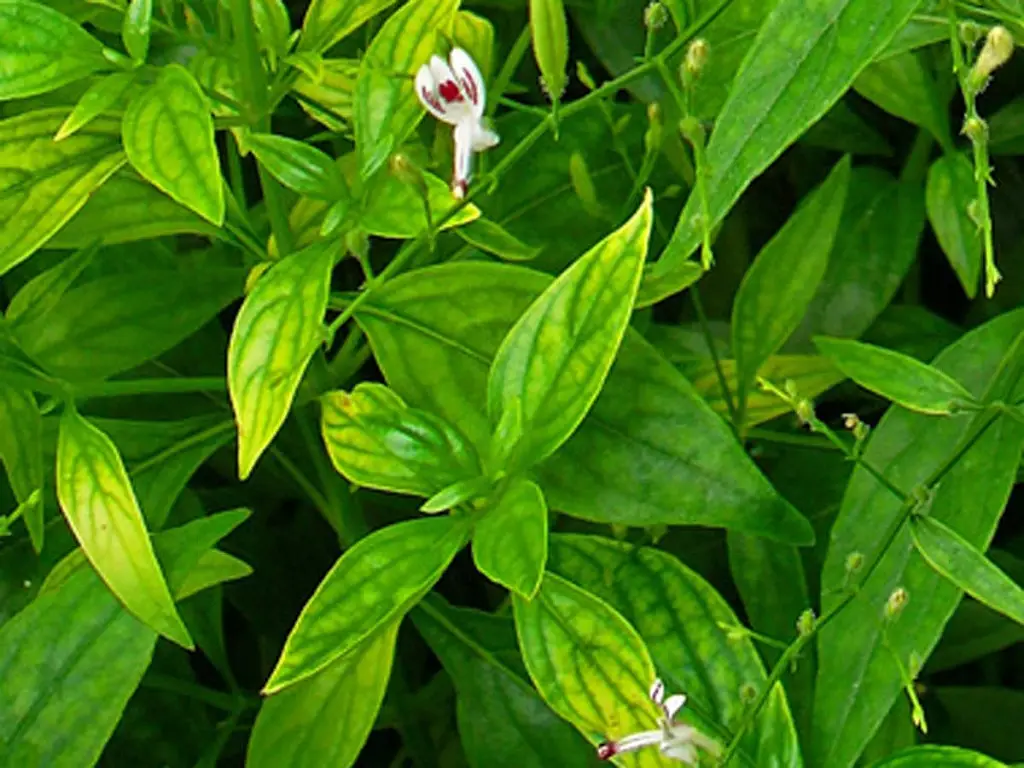
- Market demand: The pandemic has led to significant market demand, both nationally and globally. People Frequently used in Ayurvedic, Unani, Siddha, and contemporary herbal preparations. The prices of raw dried Kalmegh sell for ₹80–₹150 per kg, and processed powder or extract fetches higher prices.
- Cultivation Potential: Grows well at altitudes up to 1,200 meters and requires warm weather, moderate rainfall, and well-drained sandy loam soil.
- Medicinal uses: Kalmegh is a widely known immune system booster and liver tonic in Ayurvedic and traditional medicine. Acts as a natural antipyretic—to lower fever and reduce inflammation.
- Best farming Areas: Haridwar, Nainital, Dehradun, and Almora.
7. Mulethi (Glycyrrhiza glabra)
“Mulethi” (Glycyrrhiza glabra) is one of the best medicinal plant in Uttarakhand and a herb with a sweet savor/taste and is endowed with various medicinal properties and is commonly used in both the Ayurvedic and pharmaceutical industries. Considering the surge in demand for immune and respiratory health products, mulethi holds great market potential for farmers.
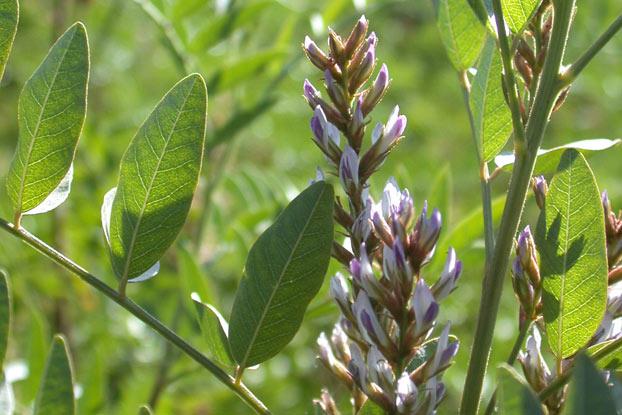
- Market Demand: There is good demand for the plant in India and abroad in herbal markets. Very commonly used in pharma, Ayurveda, herbal cosmetics, and food flavoring.The prices of Dry roots fetch ₹200–₹500 per kg, while processed powder and extracts sell at much higher prices.
- Cultivation potential: Mulethi grows in areas which are semi-arid to sub-tropical such as the Tarai and lower hill regions of Uttarakhand. It is a long-duration crop and takes around 18–24 months to mature. Have firm market interface, and the incentive by the government to grow licorice under (National Medicinal Plants Board (NMPB).
- Medical uses: Herbal teas, tonics, throat lozenges and cosmetics all elicit this favourite. Provides immune enhancement and adrenal support.
Best farming Areas: Haridwar, Udham Singh Nagar, Dehradun.
Market Overview & Trends
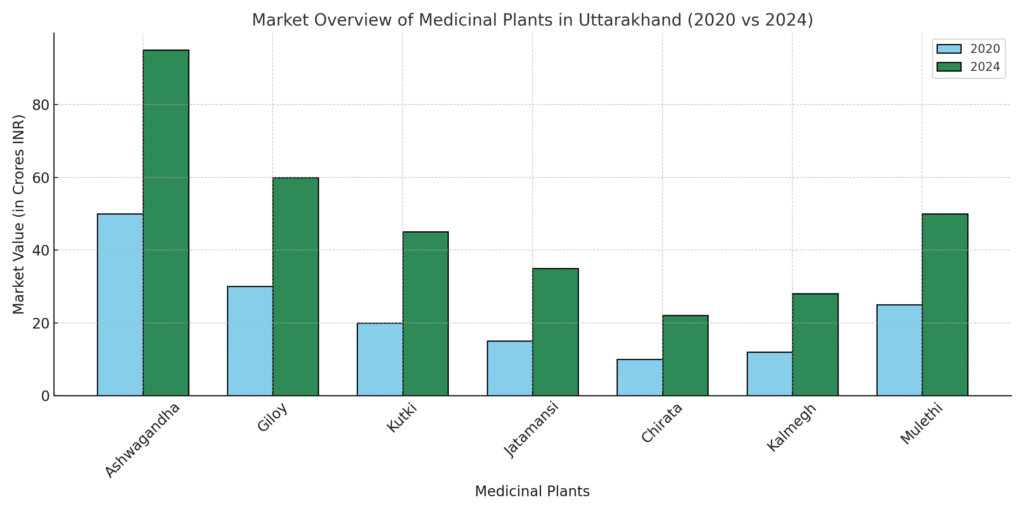
Government Schemes & Support
Cultivating profitable medicinal plants to grow in India not only ensures good returns but also promotes sustainable agriculture. Uttarakhand, being a herbal-rich state, provides ideal conditions for cultivation and government-backed support for herbal projects.
The Government of Uttarakhand, in partnership with central agencies and NGOs, is actively supporting medicinal plant farming through a range of schemes—covering financial aid, training, cultivation assistance, and marketing support. With rising global demand for natural remedies and Ayurvedic herbs from Uttarakhand,products, farmers have a golden opportunity to diversify income while preserving biodiversity. Taking advantage of these schemes can turn traditional herbal knowledge into sustainable livelihoods.
Opportunities & Challenges for Investors from Outside Uttarakhand
| Aspect | Opportunities | Challenges |
| Market Demand | High demand for top medicinal plants globally | Market volatility and price fluctuations |
| Government Support | Subsidies, training from NMPB & AYUSH | Legal norms for restricted species, permits required |
| Property Investment | Affordable land with agri-tourism potential | Land purchase limits for outsiders (max ~250 sq m) |
| Climate Suitability | Diverse zones ideal for various herbs | Requires altitude-specific know-how |
| Business Models | Scope for herbal farming + wellness retreats | Needs good planning and business understanding |
| Processing & Exports | Export potential for value-added herb products | Limited local processing, high logistics cost |
| Local Collaboration | Can partner or lease from local farmers | Requires building trust and community ties |
| Skill & Knowledge | Training available via government & agri bodies | Herbal farming is technical and certification-dependent |
Conclusion
Uttarakhand offers a unique opportunity for those looking to invest in herbal farming. With a variety of profitable medicinal plants to grow in India, especially in this region, the potential for high returns and sustainable growth is immense. It’s important to engage responsibly protecting the environment and supporting local communities. Whether you’re a farmer, investor, or traveler, now is the perfect time to explore Uttarakhand’s medicinal plant potential through cultivation, business, or eco-tourism.
At Square Foot Investor, we help you find the right agricultural land in Uttarakhand—perfect for medicinal plant cultivation and eco-friendly investments. Connect with us to start your green investment journey today.
Discover, invest, and grow with Uttarakhand’s herbal heritage for a healthier tomorrow.
Faqs
Q1. What makes Uttarakhand ideal for growing medicinal plants?
A: The region’s diverse climate and rich forests provide perfect conditions for cultivating high-quality medicinal herbs.
Q2. Can non-residents purchase farmland in Uttarakhand for herbal cultivation?
A: Non-residents can acquire limited agricultural land or collaborate with locals for larger farming projects.
Q3. Are these plants commonly used in traditional health remedies?
A: Absolutely! Herbs like Ashwagandha and Giloy are staples in Ayurvedic and herbal wellness products.
Q4. Do I need any permission to cultivate medicinal plants here?
A: Generally no, but some rare or protected species may require government permits to ensure conservation.
Q5 How can Square Foot Investor help?
A: We assist investors in finding ideal farmland in Uttarakhand for medicinal plant cultivation and eco-agriculture ventures.
Q6. What are some unique Ayurvedic plants found in the hilly regions of Uttarakhand that are highly demanded and exotic?
A: Unique and exotic Ayurvedic plants like Jatamansi, Kutki, and Chirata grow in Uttarakhand’shills. These herbs are prized for their medicinal properties and have strong market demand both in India and abroad.




